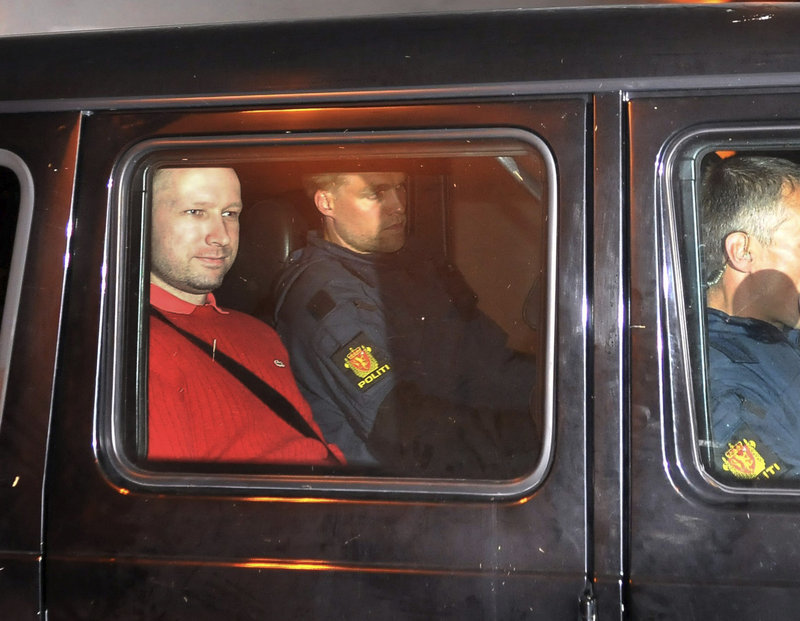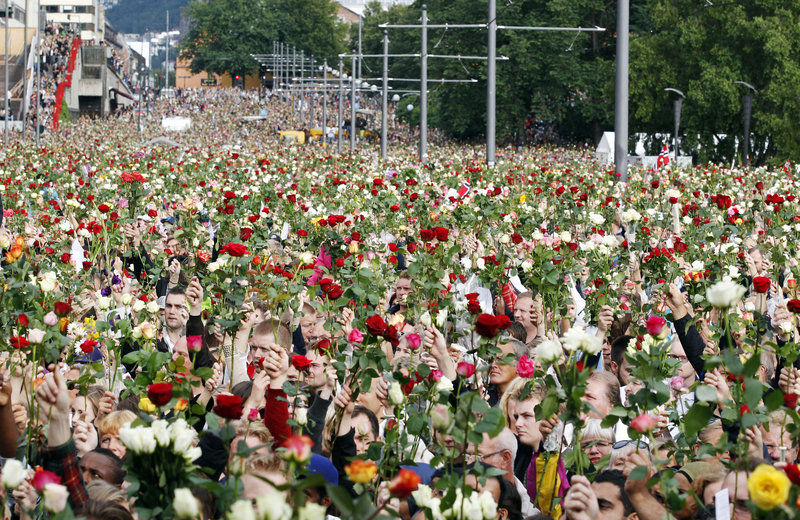OSLO, Norway – It was supposed to be a defining moment for Norwegian terror suspect Anders Behring Breivik.
He had hoped that Monday’s hearing into last week’s twin attacks would be televised live by the world’s media, authorities say. He wanted to dress in uniform to defend his actions as part of a bid to trigger an anti-Islamic revolution in Europe.
But to his disappointment, Breivik’s much-anticipated first court appearance was neither seen nor heard by the public. A Norwegian judge ruled the proceedings should be held behind closed doors, siding with government prosecutors who are increasingly nervous about giving the suspect a forum to espouse his radical views.
Inside the courtroom, Breivik was said to have listened calmly as he was formally charged with violating Norway’s anti-terrorism laws and remanded to solitary confinement for the next four weeks.
During a media briefing after the hearing, Judge Kim Heger said Breivik confessed to the attacks — which police now say killed 76 people, rather than the previously reported toll of 93 — but pleaded not guilty to the terrorism charges, justifying his actions as part of an anti-Muslim campaign.
The 32-year-old suspect also claimed to be working with two other cells, although police had said previously that he told them he acted alone. Norwegian officials said it remains unclear whether Breivik is part of a wider conspiracy or is a lone megalomaniac.
But as more is learned about Breivik, through friends, family and a 1,500-page manifesto he released on the Internet, it seems likely that he is relishing the attention now being focused on his life and ideas.
His manifesto, released shortly before Friday’s violence, refers to attacks like the bombing in downtown Oslo and the hour-long shooting massacre at a youth political camp retreat as a “marketing” tool designed to focus international attention on his extremist ideology.
“Unfortunately, I don’t think he’s crazy,” said Peter Svaar, a childhood friend of Breivik’s. “He’s cold, intelligent and resourceful. He’s playing us all like a piano.”
Svaar, a journalist at Norwegian broadcaster NRK, said he believes Breivik is only halfway through a carefully planned “ideological operation” in which he hopes to use his arrest and trial to disseminate his “sick political analysis.”
The manifesto is a mix of historical analysis, ideology and a personal diary, detailing his efforts over several years to buy weapons and bomb-making materials, experiment with explosives and create a double life to shield his activities from family, friends and government.
But while Breivik portrays himself as a modern-day crusader, fighting against what he calls the Islamic invasion of Europe, he appears to have plagiarized some of his ideas.
Several sections are lifted directly from the writings of U.S. mail bomber Ted Kaczynski, though Breivik substitutes Kaczynski’s condemnation of “leftism” for his own pet peeves: “cultural Marxism” and “multiculturalism.”
“I’m not sure I would call this guy an intellectual,” said Anders Ravik Jupskas, political analyst from the University of Oslo, who noted that the treatise, written in English, is filled with grammatical errors.
“He’s more of a copycat,” Jupskas said. “It’s easy these days to take stuff from the Internet. The manifesto is a kind of erratic mix of different genres. He tries to present himself as a crusader and part of a long tradition.”
In his writings, Breivik describes growing up in a relatively happy, affluent, yet broken home. He writes of his interest in hip-hop and break dancing, but says he rejected the skinhead movement because he didn’t like the “dress code.”
In a candid, sometimes chatty tone, he portrays himself not as a loner or social outcast, but as someone who enjoys Red Bulls and vodka with friends, flirts with girls and bulks up on steroids.
He refers to himself as a “laid-back type and quite tolerant on most issues. … As all my friends can attest to, I wouldn’t be willing to hurt a fly, and I have never used violence against others.”
Of his flaws, he admits to being self-righteous, egotistical and arrogant.
Meanwhile, police revealed they had dramatically overcounted the number of people slain in the shooting spree on Utoya island, lowering the death toll there from 86 to 68. Police also raised the toll from a bombing outside the government’s headquarters in Oslo from seven to eight.
The sharp reduction in the death toll adds to a list of police missteps: They took 90 minutes to arrive at the island retreat after the first shot, and survivors who called emergency services reported being told to stay off the lines unless they were calling about the Oslo bombings.
On Monday, police revealed that their entire Oslo helicopter crew had been sent on vacation and thus couldn’t be mobilized to the scene.
Oslo began to get back to normal Monday. The entire country paused for a minute of silence in honor of the victims, then later in the day, 150,000 people filled the city’s streets to mourn the dead with a rose vigil that ended in the heart of the city.
– The Associated Press contributed to this report.
Copy the Story Link
Send questions/comments to the editors.




Success. Please wait for the page to reload. If the page does not reload within 5 seconds, please refresh the page.
Enter your email and password to access comments.
Hi, to comment on stories you must . This profile is in addition to your subscription and website login.
Already have a commenting profile? .
Invalid username/password.
Please check your email to confirm and complete your registration.
Only subscribers are eligible to post comments. Please subscribe or login first for digital access. Here’s why.
Use the form below to reset your password. When you've submitted your account email, we will send an email with a reset code.